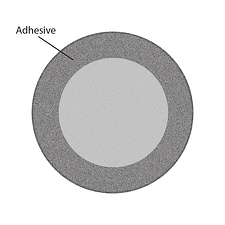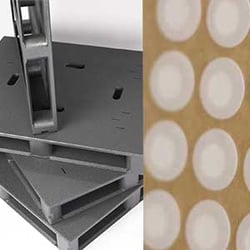Zoned adhesive lamination describes the process of laminating a selective pattern of PSA (pressure-sensitive adhesive) onto another material to achieve a specific function. Simply said, this process involves manufacturing a multi-layer part in which the layers have different geometries. This occurs through a process of conversion - laminating materials together, precisely die cutting those materials, and pulling away from the unwanted PSA material from the finished part.

Zoned adhesive patterns are often required for filter and venting die-cut components and often include a PSA layer. As you can see in this image, the mesh is cut into a circle while the adhesive is cut into a ring, which allows air and sound to flow through the center of the mesh.

Many applications, like electronic device enclosures, require filters and vents to act as barriers to dust, dirt, and moisture to protect the components within the product while allowing air and sound to pass. The precise zone of adhesive allows for secure bonding while also allowing the filter or mesh to function properly.
Check out the various layers in the diagram below. Marian starts the converting process with each layer in a large log roll. We then slit each roll to a specific width. Each roll is placed onto a die-cutting machine, which combines each layer and cuts out the different geometric shapes. Each layer is cut precisely and laminated together, including the zoned adhesive. The final part adheres to a bottom liner which is rolled and carefully shipped to the customer. The final part is used in an acoustic speaker.

IP Rated Enclosures and Vents
Many electronic enclosures are required to be "waterproof", "water-proof", "dust-proof" or "ruggedized". These claims signify that the device can operate safely in harsh and extreme environments. IP Ratings are used to indicate the degree of protection. For example, IP64 means the enclosure is dust-tight and protected against water splashed from all directions. While these enclosures can be sealed shut, they still must allow air to pass in and out (venting). If the enclosure is not properly vented, the build-up of pressure during temperature changes can result in condensation and moisture buildup, and also warping of the enclosure, both resulting in damage to the electronic components. This is where vents come in!

The application story linked below provides an excellent example.
Venting Solution with Zoned Adhesive For IP Rated Enclosure of a Smart Shipping Pallet
View Filter, Mesh, Vent, and Adhesive Material Datasheets
Zoned Adhesive Components can be very complex. Marian has years of experience creating these complex parts at tight tolerances. Interested in learning more? Please contact us.
Success Story: Filter for Air In-take on a Respiratory Device
Marian combines multiple die-cut components into one layered filter, resulting in ease of application and significant time savings for the customer.



